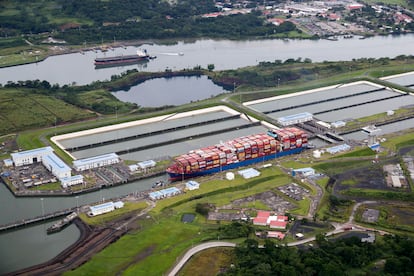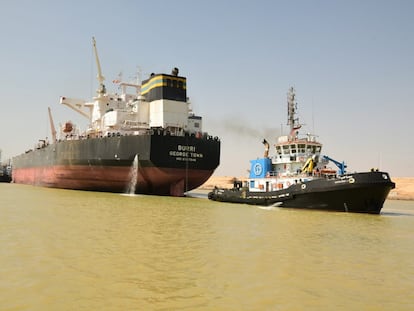The economic impact of the Panama Canal jam: Inflation and shipping losses
Global cargo companies could see millions in losses, but the biggest blow will be to consumer prices, which are set to rise, especially in the United States

More than 100 cargo ships are waiting to cross the Panama Canal, which has been forced to reduce capacity due to a devastating drought. The backlog could fuel inflation, especially in the United States, and cause huge losses for shipping companies that cross through the strait.
A severe drought in the Central American region, combined with Panama’s historically inefficient water processes, have reduced the water levels in the canal. The levels have fallen so low that the Panama Canal Authority has had to reduce the number of ships that cross each day from 36 to 32.
“Slightly more than a hundred ships on both sides of the Canal [are waiting to transit],” the authority said in a press release Tuesday. The economic impact will be felt most strongly in the United States, where prices for the delayed goods may rise. U.S. commodity export and import containers account for 73% of Panama Canal traffic, representing about $270 billion in cargo. Panama will not likely to be hit as hard by the backlog, as the canal only generates 6% of the country’s gross domestic product (GDP).
Shipping companies are set to incur heavy losses due to the bottleneck. Maersk, which is the second-largest shipping company in the world, said it was working to ensure the backlog did not disrupt its deliveries. “We follow the guidance from the Panama Canal and adapt our intake on relevant services in advance of the departure at origin. Maersk remains committed to minimizing disruptions to our operations,” it said in a press release. The Danish company moves more than four million TEU (Twenty Foot Equivalent Unit) vessels every year. In 2021, it saw its revenues reach $62 billion. Maersk added that the low water levels in the Panama Canal were a stark reminder of the climate crisis, and its ripple effect on global supply chains.
There is still no estimate of how much the Panama Canal jam will cost shipping companies, but the situation is a reminder of the 2021 crisis in the Suez Canal in Egypt. In that case, shipping companies suffered multi-billion dollar losses when the Ever Given container ship got stuck and blocked access to the canal.
For economist Eduardo Zegarra, the backlog in Panama is a sign of what he has been warning of for years. In 2017, the specialist in agricultural and water issues carried out a study for the Inter-American Development Bank (IDB), in which he estimated that the water levels in the canal would fall so low that it would affect the global supply chain. “Most likely it will happen two or three times,” he predicted.
Climate change is causing severe droughts in some parts of the world, while other countries are seeing rising sea levels devour coastal lands. According to Zegarra, climate change is the main cause of the problems in the Panama Canal, but it is not the only one. “There is a serious problem with the very inefficient use of water for drinking water consumption in Panama City. The rates paid by the population are quite low. They do not even cover the basic costs of production,” he explained.
In June 2016, a third lane for transit was opened in the Panama Canal, which increased its capacity. However, no investment was made to expand the water source for the canal, says Zegarra. The basin that supplies water to the canal is the same one that supplies the population of Panama City, he explains. “If you look at the value of water for canal use compared to drinking water, there is an almost fivefold differential. This could be studied by authorities, in order to find formulas to create greater efficiency in the use of drinking water more efficient, which would provide a little more availability for water use in the canal,” said Zegarra.
Other incidents
Two other incidents in canals have also been recently recorded. The first took place in the Suez Canal, where there was “slight contact” between a liquified natural gas carrier and an oil tanker caused traffic to be suspended for several hours. By Wednesday, traffic had resumed normally.
The second incident took place in the province of Çanakkale, in western Turkey, when a fire broke out for unknown reasons. Authorities were forced to suspend part of the maritime traffic through the Dardanelles Strait and to preventively evacuate nine urban centers, as reported by the Turkish channel NTV.
Sign up for our weekly newsletter to get more English-language news coverage from EL PAÍS USA Edition
Tu suscripción se está usando en otro dispositivo
¿Quieres añadir otro usuario a tu suscripción?
Si continúas leyendo en este dispositivo, no se podrá leer en el otro.
FlechaTu suscripción se está usando en otro dispositivo y solo puedes acceder a EL PAÍS desde un dispositivo a la vez.
Si quieres compartir tu cuenta, cambia tu suscripción a la modalidad Premium, así podrás añadir otro usuario. Cada uno accederá con su propia cuenta de email, lo que os permitirá personalizar vuestra experiencia en EL PAÍS.
¿Tienes una suscripción de empresa? Accede aquí para contratar más cuentas.
En el caso de no saber quién está usando tu cuenta, te recomendamos cambiar tu contraseña aquí.
Si decides continuar compartiendo tu cuenta, este mensaje se mostrará en tu dispositivo y en el de la otra persona que está usando tu cuenta de forma indefinida, afectando a tu experiencia de lectura. Puedes consultar aquí los términos y condiciones de la suscripción digital.
More information
Archived In
Últimas noticias
There is as much life left to discover on planet Earth as that which is already known
Dozens presumed dead, around 100 injured in fire at Swiss Alps bar during New Year’s celebration
Is porn for women different from conventional porn? We spoke to those who make it
Cartagena de Indias is sinking: What can the city do to mitigate it?
Most viewed
- David King, chemist: ‘There are scientists studying how to cool the planet; nobody should stop these experiments from happening’
- Reinhard Genzel, Nobel laureate in physics: ‘One-minute videos will never give you the truth’
- Oona Chaplin: ‘I told James Cameron that I was living in a treehouse and starting a permaculture project with a friend’
- Sinaloa Cartel war is taking its toll on Los Chapitos
- The Interoceanic Train, the Mexican alternative to the Panama Canal











































